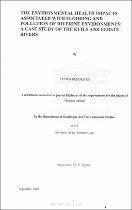| dc.description.abstract | The aim of this study was to analyse the interrelationship among hazardous environmental exposures - namely flooding and pollution of the Kuils and Eerste Rivers, and the potential health risks to the natural setting and people, alike. Today, hazards related to exposures within the environment are gaining increased attention. The realisation that human development and structural expansion impacts negatively on
the natural setting, has led to the concept of 'environmental health.' Populations of differing standards of living have experienced hazards in varying dimensions.
As illustrated by the three communities investigated in the study, it was primarily the disadvantaged socio-economic profiles which suggested that residents were exposed to wide-ranging and occasionally severe threats to health emanating from local environmental exposures. The environmental health impacts under scrutiny highlighted one of South Africa's scarce and endangered natural resources - urban river systems. The rivers are predominantly small by world standards; however, this does not exempt them from the peril of flooding. Human habitation and urban sprawl impact further on the state of inland water bodies by developing in flood-prone regions. Such activity acts as a stimulus for the augmentation of water pollution. Sadly, although expansive documentation exists regarding the risks inherently associated with both flooding and pollution, individuals tend to display dispositions of disregard. The study revealed that although the majority have displayed interest in potential environmental health hazard, they were not likely to implement habits which prevent this.
The results exemplify that the prevalence of flooding and pollution are frequently viewed in isolation of each other. In the study area this was evidently infeasible to do, as surveys and visual observation proved that habitually, one environmental exposure impacts upon, and even worsens the other.
The primary goal of the research was to detect a correlation between the quality of river water, the frequency of flooding, and the prevailing health indices of the investigated communities. The outcome suggested that although the association detected amongst the variables was small (14 o ), numerous elements in the environment exist which levitate the risk of disease and structural destruction experienced, as a result of flood hazard and river contamination. The study concludes that if environmental health benefits are to be optimised, then it is
connoted that community planning and upgrading efforts - particularly in informal settlements, acquires holistic approaches and integrated input from a wide range of sectors as well as community compliance. Therefore, health impacts emanating from risks associated with the river body should be restrained by activities and behaviours of the communities themselves. Moreover, controlling negative impacts should also be a key initiative in the operation of municipal bodies. | en_US |

